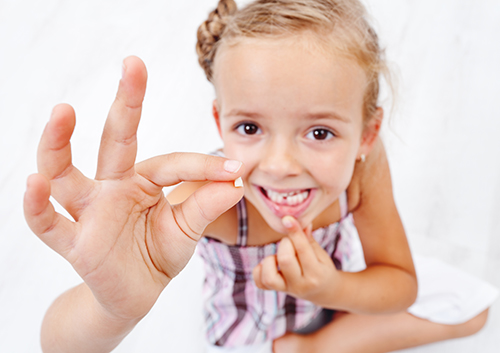August 10th, 2022

Some lucky babies wake one morning displaying a brand new tooth to the complete surprise of their unsuspecting parents! But your happy baby is irritable and drooling. Or your hearty eater doesn’t feel like finishing her food. Perhaps she finds it hard to go to sleep when she’s usually nodded off before you finish the first lullaby. A small number of children suffer little or no discomfort teething, but for the majority of babies who do, here are some helpful ways to ease their teething pain.
- Massage--Rubbing your baby’s gums with a clean finger or piece of gauze—gentle pressure is all you need. And do be careful of your fingers once those teeth start coming in!
- Chewing—there are many colorful and easy to grasp teething toys available, including BPA-free models.
- Cool Relief—Cool a solid teether in the refrigerator to help ease discomfort. Placing a teething ring in the freezer is not recommended, as extreme cold can be damaging to little mouths and gums.
- Comfort Food—If your baby is eating solid foods, try cold applesauce or other purees.
- Skin Care—Drooling is often part of the teething process, but try to keep your child’s face free from rash and chaffing by wiping with a clean cloth when necessary.
And while you are trying to keep your baby comfortable, also be sure to keep her safe!
- Know what your baby is putting into her mouth. All teething items should be non-toxic and free of harmful chemicals. Teethers filled with fluids may break or leak, so a solid toy is best.
- Make teething items size-appropriate. Avoid anything small or breakable that might present a choking hazard.
- Over-the-counter gels and liquids containing benzocaine, meant to reduce pain in the gums and mouth, may on rare occasion lead to serious health conditions in small children. Always check with Drs. Don and Mindy or your pediatrician before buying an over-the-counter teething medication for your baby.
For many babies, teething can be a long and sometimes difficult process. If there is anything we can do to help you and your baby in this journey, please give our Charleston office a call.
August 3rd, 2022

While the last baby teeth generally aren’t lost until age ten or 11, most children stop believing in the tooth fairy by the time they're seven or eight. Of course, children are more than happy to play along with the game when there’s money at stake! While it is impossible to know what the tooth fairy does with all those teeth (are they labeled and stored like museum pieces in a giant fairytale castle?), it is possible to trace the history and myth of the tooth fairy to several cultures and traditions. Drs. Don and Mindy and our team learned about some interesting myths about the tooth fairy!
The Middle Ages
Legend has it that Europeans in the Middle Ages believed a witch could curse someone by using their teeth, so it was important to dispose of baby teeth correctly. Teeth were swallowed, buried, or burned. Sometimes baby teeth were even left for rodents to eat. Despite being pests, rodents were valued for their strong teeth; it was generally believed a tooth fed to a rodent would lead to the development of a healthy and strong adult tooth.
Eighteenth Century France
The tooth fairy myth began to show more characteristics of a conventional fairytale in 18th century France. La Bonne Petite Souris, a bedtime story, tells the strange tale of a fairy that changes into a mouse to help a good queen defeat an evil king. The mouse secretly hides under the evil king’s pillow and defeats him by knocking out his teeth.
Scandinavian Lore
So, why does the tooth fairy leave money under the pillow? The idea of exchanging a tooth for coins originated in Scandinavia. Vikings paid children for a lost tooth. Teeth were worn on necklaces as good luck charms in battle. While the idea of exchanging a tooth for coins quickly spread throughout the rest of Europe, a fierce, horn-helmeted Viking is far cry from the image of a fairy collecting teeth.
While the tooth fairy as children know her today didn’t make an appearance until the 1900s, tooth myths and rites of passage have existed in numerous cultures since the dawn of time.
July 27th, 2022

It’s common for children to suck their thumb at a young age. Drs. Don and Mindy and our team want you to understand the potential issues that can surface down the road if the habit isn’t broken early on.
It’s normal for infants to explore the function of their mouths by putting objects like their thumbs inside it. You shouldn’t be concerned if your baby regularly sucks his or her thumb. For infants who are still growing their baby teeth, thumb sucking can help with stimulating growth and development of their baby teeth.
Thumb sucking is not a problem among infants because they generally do it to sooth and comfort themselves. Problems can occur of kids continue the habit when their baby teeth begin to fall out, around six years of age.
If you have a young child whose adult teeth are starting to come in, that’s when thumb sucking can start to be a problem. Most children stop thumb sucking between the ages of two and three years. According to the American Dental Association, if thumb sucking continues as adult teeth come in, this can lead to problems involving improper alignment of teeth and growth of the jaw, gums, and roof of the mouth.
It may also affect your child’s speech after that, by causing a lisp or other speech impediments. As a parent, you may need to begin to regulate and intervene if thumb sucking starts to become a bigger problem for your child.
How to Stop Thumb Sucking
- Provide comfort to your child if thumb sucking happens when he or she is anxious.
- Limit thumb sucking initially to bedtime or naptime.
- Employ positive reinforcement for good behavior.
- Talk with your child about the potential problems that come from this habit.
- Distract your son or daughter with activities such as fun games any time you notice it starting.
- Involve your little one in choosing methods for stopping, like positive rewards.
- Have Drs. Don and Mindy talk to your child to reinforce concerns about thumb sucking.
Don’t forget that thumb sucking is a common habit that many children indulge in, and it should not be a concern right away. If you’re worried about your child’s thumb-sucking habit, start to address the issue as soon as possible.
The above techniques can help to reduce the amount of time your child sucks a thumb. Drs. Don and Mindy and our team are here to help you if you have any questions or concerns about this habit.
Feel free to call our Charleston office and we will be happy to help you and your child.
July 20th, 2022

Many people think dental fluorosis is a disease, but it’s not; it’s a condition that affects the appearance of your tooth’s enamel, not the function or health of the teeth. These changes may vary from tiny, white, barely noticeable spots to very noticeable staining, discoloration, and brown markings. The spots and stains left by fluorosis are permanent and may darken over time.
Dental fluorosis occurs in children who are excessively exposed to fluoride between 20 and 30 months of age. Only children ages eight years and younger can develop dental fluorosis. Why? That is the period when permanent teeth are still developing under the gums. For kids, fluorosis can cause significant embarrassment and anxiety about the appearance of their teeth. No matter how much they might brush and floss, the fluorosis stains do not go away.
Many well-known sources of fluoride may contribute to overexposure, including:
- Fluoridated mouth rinse, which young children may swallow
- Bottled water which is not tested for fluoride content
- Inappropriate use of fluoride supplements
- Exposure to water that is naturally or unnaturally fluoridated to levels well above the recommended levels
One way to reduce the risk for enamel fluorosis is to teach your children not to swallow topical fluoride products, such as toothpaste that contains fluoride. In fact, kids should use no more than a pea-sized amount of fluoride toothpaste when brushing, and children under the age of two shouldn’t use fluoride toothpaste at all.
Dental fluorosis can be treated with tooth bleaching, microabrasion, and conservative composite restorations or porcelain veneers. Please give us a call at our office to learn more or to schedule an appointment with Drs. Don and Mindy.



